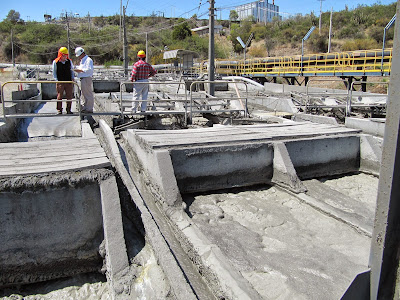Last week's visit to Minera Valle Central (posting of 15th October) was one
of the most interesting mine visits that I have ever undertaken. The plant
treats old and current tailings from El Teniente copper mine, 40km away, and
uses natural gravity flow in a process known as cascade flotation. I am not sure
whether this is unique to this plant, but I have certainly not seen or heard of
it being used anywhere else.
The tailings are introduced into four parallel troughs, two kilometres in
length, in a stepped, or cascade, arrangement. As the slurry flows down the
incline, air is induced by the natural turbulence. No reagents are added, as
these are already present in the water in the tailings. The mineralised froth
which is produced is fed every few metres into a kind of pinched sluice, which
deepens the froth, which is diverted as a concentrate. Final tailings is the
slurry which remains after the 2-km journey. It is fascinating as you will see
in this short YouTube movie.
 |
| Cascade flotation |
Correct me if I am wrong, but I believe this was designed by Rainer Imhof,
the inventor of the Imhoflot G cell, which was displayed at Procemin '13 in
Santiago.
Making use of natural gravity flow is, of course, nothing new. 19th century
miners built their processing plants on hillsides to make use of gravity flow
before the advent of centrifugal pumps, but I have never seen it used in
flotation.I have seen something similar in Malaysia however. Palong concentrators also utilise long sloping troughs down which slurry flows over a series of baffles, behind which the tin mineral, cassiterite, and other heavy minerals such as monazite, zircon and ilmenite settle out. Periodically the flow is stopped, the baffles are lifted and the heavy mineral concentrate is sluiced out.
 |
| Palong concentrator, Ipoh, Malaysia, 1981 |












-EDIT.jpg)





Hi Barry, As much as Rainer Imhof has invented and designed many things, unfortunately the cascade flotation at MVC is not one of them. I’m sure someone will correct me but I think it was developed in house by Codelco to, as you say, to use the gravity advantage of the terrain and the residual reagents in the tailings. Maelgwyn Mineral Services and Ingenieria de Minerales are working on systems to further upgrade the product of cascade flotation.
ReplyDeleteThanks for the clarification Mike. I wasn't sure, but a number of people at the conference in Santiago thought that it was designed by Rainer. Amazing to see though!
DeleteSince the 1940s in Chile and Peru tailings would be sent down the river. The each drop, water fall or rapids the artesanal guys set up make shift versions of this, collecting the froth for sale. CMV did it industrially, but the credit either lies with the genius that decided to use a river for tails disposal or Tío Juanito, the farmer that noticed that mineralized froth was collecting at each drop.
ReplyDeleteWhen the tin price was at its highest in the 1980s, South Crofty mine in Camborne discharged its tailings into the Red River which flowed into the sea on the north coast of Cornwall. A small 'tin streamer', Tolgarrick Tin diverted the river flow into its processing plant, which made a very saleable tin concentrate using Mozley hydrocyclones for desliming, and concentration on shaking tables.
DeleteFascinating stuff... one man's tails is another mans feed!
ReplyDelete